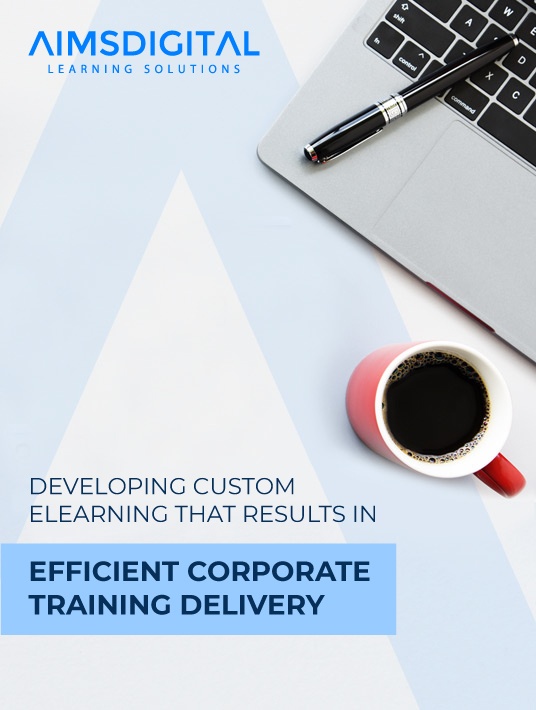Some Simple Tips To Make eLearning More Engaging
Custom eLearning means providing a customized solution for learner specific problems. Several business giants vouch for and invest in providing a custom eLearning experience for their clients and employees. The target audience of eLearning courses includes busy learners such as students or corporate employees. When developing an eLearning course, it is important to know the learners and their level of knowledge-grasping capacity. Engaging a learner and making a course interesting for them can be a challenging task. When we create a course, two major factors should be considered—good content and visual design—which, when combined give us the desired Learner Experience.

If the target audience is students between the ages of 6-8, then dumping a bunch of theories and concepts in their course will lead to cognitive load. They would eventually refuse to take the course. However, an audience that is comprised of adults may respond better to a course with theories and facts. eLearning provides a learner with the liberty to take up a course on a device of their choice—smartphones, laptops or desktops. This is where responsive eLearning design comes into the picture. Courses are being designed in such a way that they are compatible with almost all devices. Such a facility is very useful and suitable for learners willing to take their study room with them wherever they go.
Engaging Content
For engaging the learners, we need to have a strong understanding of their grasping power. Once that is clear, it is necessary to state the learning goals of a lesson. A good eLearning course should be built around the set learning outcomes expected from the learners. Discussions with the SMEs and clients can help you get a clear idea of the learner’s background, after which the process of content creation can begin. We must ensure that the content and the course are effective. The content should be presented in a way that the user can relate to, which will induce them to contemplate over it and it will help them retain the knowledge for a long period of time. Once these targets are achieved, consider your course to be a success! Brownie points to you if the learner demonstrates the completion of the set learning outcomes with marked effectiveness.
Let us now understand the importance of presenting a topic. Consider explaining the concept of photosynthesis to a group of middle school students. Here are some of the strategies used for explaining the concept:
- Explain and give the chemical formulae involved in the process.
- Explain the process with a diagram.
- Explain the process with a diagram and an animation illustrating the consumption of carbon dioxide and water by the plant that gives out oxygen and glucose as a product of this process.
Which of these strategies would be best received by your audience? The answer to this question depends on a lot of factors. The content, visuals, and animations would vary according to their preset knowledge, if any, and their knowledge accretion capacity.
Let us now look at the 6 different ways to make the content engaging.
1. Storytelling
Historically, this has been one of the best ways to teach or explain concepts. From Panchatantra to movies to media service providers like Netflix, the art of storytelling has transcended with time. You can always start your course with a story to support your content.
2. Gamification
The inclusion of games in a course is also one of the best ways to make a student learn faster. You can either make a game-based course or include small games within knowledge checks throughout the course. Gamification can be made more engaging by adding features like reward points and incentives to motivate the learner.
3. Video
It has been proven that humans learn better when introduced to multimedia-based learning courses. This way, a topic is explained in a simple yet effective manner without making it boring.
4. Scenario-Based Learning (SBL)
This can also be an effective way of teaching. The inclusion of scenarios that the learners can relate to can help them think over a topic. A lengthy lesson can be divided using scenario-based learning concepts. SBL will help the learners remember concepts in the future as they will be able to recall them and relate them to a scenario.
5. Blended Learning
This can be helpful for explaining complex topics that require detailed explanation. Blended learning can also be used when a hands-on experience is required for taking up an online course.
6. Strong Feedback
After completing an online course where you self-learn and are self-motivated, a strong feedback system is a must. A quiz is always added with the completion of a lesson, but it is necessary to ensure that feedback is provided to the learner. This will help them know where they stand and need to improve.
Perfect Visual
- Keep it simple
Keep the design simple and clear to provide a better User Experience. - Choose the colors wisely
Pick your color palette and stick to it. Try and select 2-3 colors. You may want to choose the colors included in the company’s guidelines or logo. - Space is good
Never hesitate to keep white spaces on the screen. These spaces give a clean look to the course and make it easier for the learner to read. Effective use of space makes the design clearer and helps in making it interactive thereby increasing the probability of learner engagement. - Use relevant images
Always choose images that are relevant to the topic/scenario. The user should be able to read and understand the content easily. Images are an important source of conveying the message. - Add interesting animation wherever possible
Animations play a very important role in the learner’s engagement in the course. If made interactive and interesting, animations can keep the user engaged for a long period of time. - Repeat when needed
This helps provide a consistent User Experience. Consistency makes users more comfortable. Remember that the eyes work in a certain way by default. Using repetition to keep the user familiar with the design elements will be advantageous. We can use shapes, colors, textures, fonts, etc. to maintain consistency via repetition. - Use responsive design
As we want our users to be able to learn in an environment of their choice, we must implement responsive designs within our courses.
Download the eBook: "Developing Custom eLearning That Results In Efficient Corporate Training Delivery" to learn of the nuances of developing custom eLearning from an organizational perspective or watch this webinar to deliver efficient corporate training through custom eLearning.









